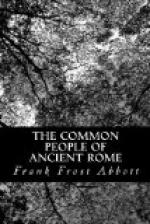The towns which we have mentioned were only a few miles from Rome. Beyond them, and occupying central Italy and a large part of southern Italy, were people who spoke Oscan and the other Italic dialects, which were related to Latin, and yet quite distinct from it. In the seaports of the south Greek was spoken, while the Messapians and Iapygians occupied Calabria. To the north of Rome were the mysterious Etruscans and the almost equally puzzling Venetians and Ligurians. When we follow the Roman legions across the Alps into Switzerland, France, England, Spain, and Africa, we enter a jungle, as it were, of languages and dialects. A mere reading of the list of tongues with which Latin was brought into contact, if such a list could be drawn up, would bring weariness to the flesh. In the part of Gaul conquered by Caesar, for instance, he tells us that there were three independent languages, and sixty distinct states, whose peoples doubtless differed from one another in their speech. If we look at a map of the Roman world under Augustus, with the Atlantic to bound it on the west, the Euphrates on the east, the desert of Sahara on the south, and the Rhine and Danube on the north, and recall the fact that the linguistic conditions which Caesar found in Gaul in 58 B.C. were typical of what confronted Latin in a great many of the western, southern, and northern provinces, the fact that Latin subdued all these different tongues, and became the every-day speech of these different peoples, will be recognized as one of the marvels of history. In fact, so firmly did it establish itself, that it withstood the assaults of the invading Gothic, Lombardic, Frankish, and Burgundian, and has continued to hold to our own day a very large part of the territory which it acquired some two thousand years ago.
That Latin was the common speech of the western world is attested not only by the fact that the languages of France, Spain, Roumania, and the other Romance countries descend from it, but it is also clearly shown by the thousands of Latin inscriptions composed by freeman and freedman, by carpenter, baker, and soldier, which we find all over the Roman world.
How did this extraordinary result come about? It was not the conquest of the world by the common language of Italy, because in Italy in early days at least nine different languages were spoken, but its subjugation by the tongue spoken in the city of Rome. The traditional narrative of Rome, as Livy and others relate it, tells us of a struggle with the neighboring Latin hill towns in the early days of the Republic, and the ultimate formation of an alliance between them and Rome. The favorable position of the city on the Tiber for trade and defence gave it a great advantage over its rivals, and it soon became the commercial and political centre of the neighboring territory. The most important of these villages, Tusculum, Praeneste, and Lanuvium, were not more than twenty miles distant, and the people




